5.5.1 Basics of the Normal Distribution
In this topic we will learn how to:
- understand the use of a normal distribution to model a continuous random variable, and use the normal distribution tables
- understand how to standardize a normally distributed random variable
- solve problems concerning a variable X, where X \sim N\left(\mu, \sigma^{2}\right), including finding the value of P(X > x_{1}) or a related probability, given the values of x_{1}, \mu and \sigma.
The normal distribution is a continuous distribution. This means it defines probabilities for a continuous random variable. A continuous random variable takes on continuous values. Continuous values are values that are not discrete and encompass a range of values over a specified degree of accuracy. The normal distribution is used for continuous quantities such as weight, height and time. At AS level you will be told if a variable follows the normal distribution, therefore, you do not need to know the conditions required for a distribution to be normal.
The notation for a normal distribution is as follows,
X \sim N\left(\mu, \sigma^{2}\right)Note: \mu is prounounced ‘mu’, \sigma^{2} is pronounced ‘sigma squared’.
The expression above reads as, ‘X follows a normal distribution, with the parameters \mu and \sigma^{2}‘. X represents a random variable, N represents a normal distribution, \mu represents the mean, \sigma^{2} represents the variance. Questions will usually give you the standard deviation instead of the variance. Remember that variance is the square of standard deviation, so when defining the distribution, ensure to put the variance and not the standard deviation. To calculate normal probabilities we use the Standard Normal Distribution Tables.\textbf{\large\textcolor{gray}{The Standard Normal Distribution}}The Standard Normal Distribution has a mean of 0 and a standard deviation of 1. It’s random variable is denoted by the letter Z. It’s distribution is as follows:
Z \sim N(0, 1)Note: You cannot use the letter Z to define any random variables, it is reserved for the standard normal distribution. Remember, that variance is the square of standard deviation, hence, variance of the standard normal distribution is still 1.
Normal distribution curves are called bell curves as they have a bell shape. Below is an example of the bell curve for the standard normal distribution. The total area under the curve is equal to 1. This allows us to calculate areas or probabilities under the curve,
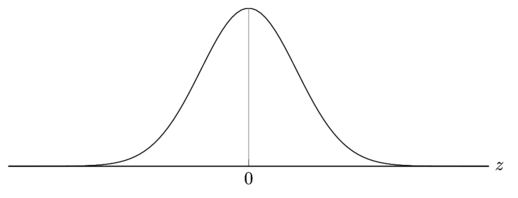
The random variables you will get in questions, we will have a different mean and variance to that of the standard normal distribution. To be able to calculate their normal probabilities we have to standardise them i.e make the mean 0 and standard deviation 1. To standardise, we use the formula: z = \frac{x - \mu}{\sigma} Where z represents the standardised value, x represents the original value before standardisation, \mu is the mean, \sigma is the standard deviation. Once you have standardized, you can use the standard normal distribution tables to determine the probabilities. To be able to determine the probabilities we need to first learn how to read the standard normal distribution tables.\textbf{\textcolor{gray}{Reading the Standard Normal Distribution Tables}}

The standard normal distribution tables are used to read z-values correct to 3 decimal places. It has 3 columns. It displays z-values ranging from 0 to 2.999. The first column is labelled as z. The second is labelled by the numbers 0 - 9. The third is labelled by, 1 - 9 ADD. To find the area of the corresponding z-value, we start by reading the first column, z. Then we read the corresponding number in the second column, 1 - 9. We record the value we get from the first and second columns. Finally, read off the corresponding number in the third column, and ADD it to our recorded value from the first and second columns.
Let’s look at an example of how to read the standard normal distribution tables.
Example 1
Find the area for the z-value 0.196.
We start off by going to \textcolor{red}{0.1} in the first column, then we go to \textcolor{red}{9} in the second column. We record the value from these two columns, which is \textcolor{#2192ff}{0.5753}. Now go to \textcolor{red}{6} in the third column. It says ADD \textcolor{#2192ff}{24}. Therefore, ADD \textcolor{#2192ff}{24} to the last two digits of your number from the first and second columns,
\textcolor{#2192ff}{0.5753} + \textcolor{#2192ff}{0.0024} = 0.5774

Example 2
Find the area for the z-value, 1.349.
We start off by going to \textcolor{red}{1.3} in the first column, then we go to \textcolor{red}{4} in the second column. We record the value from these two columns, which is \textcolor{#2192ff}{0.9099}. Now go to \textcolor{red}{9} in the third column. It says ADD \textcolor{#2192ff}{14}. Therefore, ADD \textcolor{#2192ff}{14} to the last two digits of your number from the first and second columns,
\textcolor{#2192ff}{0.9099} + \textcolor{#2192ff}{0.0014} = 0.9113

\large\textcolor{gray}{\textbf{Finding Probabilities (Areas) using the}\\ \textbf{ Standard Normal Distribution Tables}}Now that we can find areas of our corresponding z-values, let’s learn how to find areas under the normal distribution curve. Areas may be singular areas or compound areas.\textbf{\textcolor{gray}{Singular Areas}}There are four scenarios for singular areas,
\textcolor{gray}{P(Z < a)}

This can be written as,
\phi\left(a\right)\phi is a greek letter. It is read as ‘phi’. It means ‘to the left of’. So \phi\left(a\right) means we want the area to the left of a. To find \phi\left(a\right), read off the area corresponding to a on the standard normal distribution tables.
\textcolor{gray}{P(Z > a)}
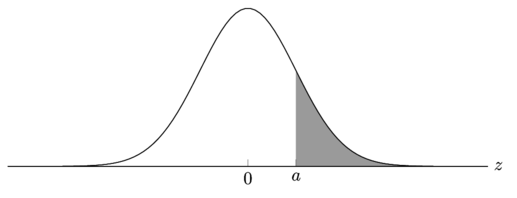
This can be written as,
1 - \phi\left(a\right)To find \phi\left(a\right), read off the area corresponding to a on the standard normal distribution tables. Substitute the value of \phi\left(a\right), into the expression above and simplify.
\textcolor{gray}{P(Z > -a)}
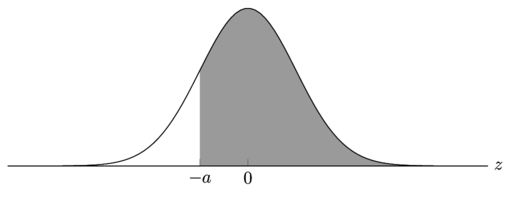
This can be written as,
\phi\left(a\right)Note: P(Z < a) is the same as P(Z > -a) because the bell curve for the standard normal distribution curve is symmetrical about its mean of 0.
To find \phi\left(a\right), read off the area corresponding to a on the standard normal distribution tables.
\textcolor{gray}{P(Z < -a)}
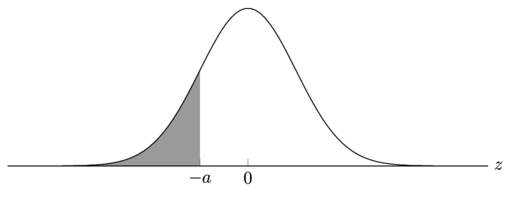
This can be written as,
1 - \phi\left(a\right)Note: P(Z > a) is the same as P(Z < -a) because the standard normal distribution curve is symmetrical. So in reality you only need to know the first 2 scenarios.
To find \phi\left(a\right), read off the area corresponding to a on the standard normal distribution tables. Substitute the value of \phi\left(a\right), into the expression above and simplify.
\textbf{\textcolor{gray}{Compound Areas}}We can also find the compound areas using the standard normal distribution curve. There are five possible scenarios,
\textcolor{gray}{P(a < Z < b)}Where a and b are both positive numbers.
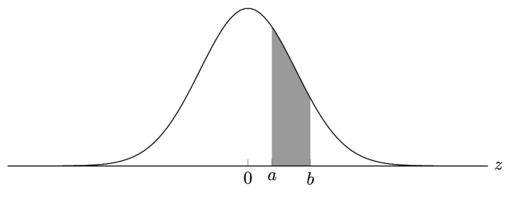
The above can be written as,
\phi(b) - \phi(a)Read off the values of \phi(a) and \phi(b) from the standard normal distribution tables. Substitute them into the expression above and simplify.
\textcolor{gray}{P(-a < Z < b)}Where a and b are both positive numbers.
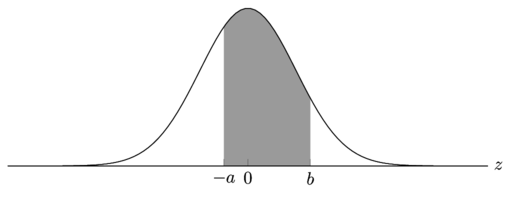
The above can be written as,
\phi(b) - \left(1 - \phi(a)\right)Read off the values of \phi(a) and \phi(b) from the standard normal distribution tables. Substitute them into the expression above and simplify.
\textcolor{gray}{P(-b < Z < a)}Where a and b are both positive numbers.
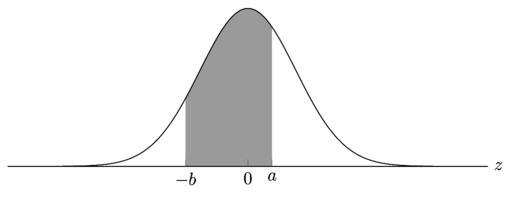
The above can be written as,
\phi(a) - \left(1 - \phi(b)\right)Read off the values of \phi(a) and \phi(b) from the standard normal distribution tables. Substitute them into the expression above and simplify
\textcolor{gray}{P(-b < Z < -a)}Where a and b are both positive numbers.
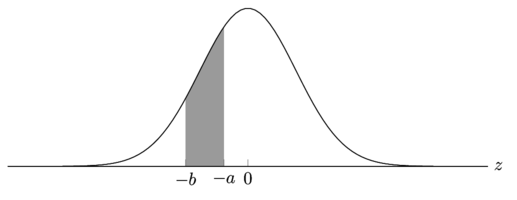
The above can be written as,
\phi(b) - \phi(a)Read off the values of \phi(a) and \phi(b) from the standard normal distribution tables. Substitute them into the expression above and simplify.
\textcolor{gray}{P(-a < Z < a)}Where a is a positive number.
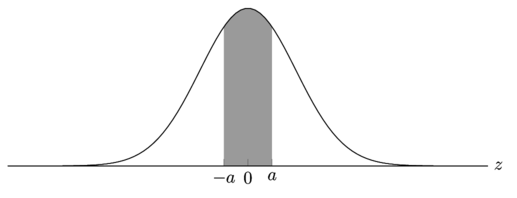
The above can be written as,
2\phi(a) - 1Read off the value of \phi(a) from the standard normal distribution tables. Substitute it into the expression above and simplify.
\textbf{\large\textcolor{gray}{Reading the Standard Normal}}\\ \textbf{\large\textcolor{gray}{Distribution Tables in Reverse}}In some instances, you will be given the area or probability, and you have to evaluate the z-value. To do that you have to use the tables in reverse. The table only has areas from 0.500 to 1.
To find the z-value using area, follow the steps outlined below:
- Sketch the bell curve of your given area. This will tell you whether your z-value is negative or positive.
- Change your area to a decimal
- Check if your area is less than 0.500. If it is, subtract it from 1 and use the new value otherwise use the original area
- Go into the main table and find your area
- Read off the corresponding values from the first and second columns. That will give you your z-value
- If your area is not in the main table, find the closest area, that is less than your given area
- Then, within that row, go to the third column and find the value that you have to ADD to get your area
- Read off the corresponding values from the first, second and third columns. That will give you your z-value
Let’s look at some examples of finding z-values from area.
Example 3
Find the z-value for an area less than 70\%.
We’ll start by sketching the bell curve for an area less than 70\%,

From the diagram we can tell that our z-value is positive.
Let’s convert 70\% to a decimal,
0.70Go into the main table and look for 0.70. In the main table, we do not have a value which is exactly equal to 0.70 so we find the closest value, which is less than 0.70,
\textcolor{red}{0.6985}

Read off the values corresponding to 0.6985 from the first and second columns. These are 0.5 and 2 respectively, this gives,
0.52To get 0.70 we have to ADD 15 to the last two decimal places of \textcolor{red}{0.6985}. Now we read off the value that corresponds to ADD 15 in the row of \textcolor{red}{0.6985}. In this instance, there is no ADD 15 so we pick the closest value, ADD \textcolor{red}{14}. ADD 14, corresponds to 4. Therefore, our z-value would be,
z = \textcolor{#2192ff}{0.524}

Example 4
Find the z-value for an area less than 5\%.
Let’s start by sketching the bell curve for an area less than 5\%,

If you look at the curve above, you will notice that our z-value will be negative.
Let’s convert 5\% to a decimal,
0.05Since 0.05 is less than 0.500, subtract it from 1,
1 - 0.05 = 0.95Go into the main table and look for 0.95. In the main table, we do not have a value that is exactly equal to 0.95 so we find the the closest value, that is less than 0.95,
\textcolor{red}{0.9495}

Read off the values corresponding to 0.9495 from the first and second columns. These are 1.6 and 4 respectively, this gives,
1.64
To get 0.95 we have to ADD \textcolor{red}{5} to the last decimal place of \textcolor{red}{0.9495}. Now we read off the value that corresponds to ADD \textcolor{red}{5} in the row of \textcolor{red}{0.9495}. ADD \textcolor{red}{5}, corresponds to \textcolor{#2192ff}{5}. Therefore, our z-value would be,
z = \textcolor{#2192ff}{1.645}

Now let’s look at some past paper questions.
1. Raj wants to improve his fitness, so every day he goes for a run. The times, in minutes, of his runs have a normal distribution with mean 41.2 and standard deviation 3.6. (9709/53/O/N/21 number 4)
(a) Find the probability that on a chosen random day Raj runs for more than 43.2 minutes.
Let’s start by defining the random variable,
X\textmd{ - r.v, times, in minutes, of Raj's runs}State the distribution and parameters of the random variable,
X \sim N\left(\mu, \sigma^{2}\right)\mu = \textcolor{#2192ff}{41.2} \ \ \ \ \sigma = \textcolor{#0f0}{3.6}X \sim N\left(\textcolor{#2192ff}{41.2}, \textcolor{#0f0}{3.6}^{2}\right)Note: Remember that we use variance as our second parameter and variance is the square of standard deviation.
Now let’s write out our problem mathematically,
P(X > 43.2)To be able to evaluate normal probabilities, we have to standardize. The formula for standardizing is,
z = \frac{x - \mu}{\sigma}P(X > 43.2)P\left(\frac{X - \mu}{\sigma} > \frac{43.2 - 41.2}{3.6}\right)P(Z > 0.556)
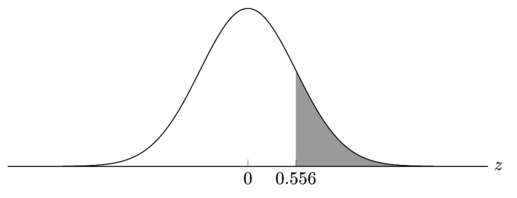
We know that, this is the same as,
P(Z > a)This simplifies to,
1 - \phi(a)1 - \phi(0.556)Use the tables to evaluate \phi(0.556),
\phi(\textcolor{red}{0.556}) = \textcolor{#2192ff}{0.7088} + \textcolor{#2192ff}{0.0020}\phi(\textcolor{red}{0.556}) = \textcolor{#2192ff}{0.7108}

Simplify the expression,
1 - \phi(\textcolor{red}{0.556})1 - \textcolor{#2192ff}{0.7108}0.28920.289Note: Give your final answer correct to 3 significant figures.
Therefore, the final answer is,
P(X > 43.2) = 0.289(b) Find an estimate for the number of days in a year (365 days) on which Raj runs for less than 43.2 minutes.
Remember that,
\textmd{X - r.v, times, in minutes, of Raj's runs}To find the number of days on which Raj runs for less than 43.2 minutes we first have to find the probability that Raj runs for less than 43.2 minutes on a random day,
P(X < 43.2)Since we evaluated P(X > 43.2) above, we can use this to help simplify our problem,
P(X < 43.2) = 1 - P(X > 43.2)This works because the total area under a bell curve is equal to 1.
Note: You can still just standardise and evaluate the resulting outcome, however, that is more tedious route.
P(X < 43.2) = 1 - 0.2892P(X < 43.2) = 0.7108Now that we have found the probability that Raj runs for less than 43.2 minutes on a random day, we can use that to estimate the number of days in a year on which Raj runs for less than 43.2,
0.7108 \times 365This simplifies to give,
259.442When approximating the number of days, always round up,
260 \textmd{ days}Therefore, the final answer is,
260 \textmd{ days}(c) On 95\% of the days, Raj runs for more than t minutes. Find the value of t.
In this case, you will notice that we’re given the area. This means we will use the standard normal distribution tables in reverse. Let’s start by writing out our problem mathematically,
P(X > t) = 0.95The formula for standardization is,
z = \frac{x - \mu}{\sigma}If we standardize we get,
P\left(Z > \frac{t - \mu}{\sigma}\right) = 0.95Note: When we standardize, the area under the bell curve does not change.
Let’s replace \frac{t - \mu}{\sigma} with z for better readability,
P(Z > z) = 0.95Let’s sketch the bell curve for our problem,
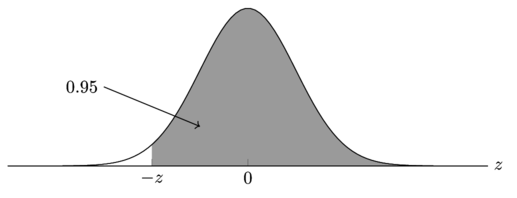
You will notice that our z-value is going to be negative. Let’s find our z-value. Start by converting 95\% to a decimal,
0.95Since 0.95 is greater than 0.500 we go straight into the main table. Find the value closest to but less than 0.95,
\textcolor{red}{0.9495}

Read off the values corresponding to 0.9495 from the first and second columns. These are 1.6 and 4 respectively, this gives,
1.64To get 0.95 we have to ADD \textcolor{red}{5} to the last decimal place of \textcolor{red}{0.9495}. Now we read off the value that corresponds to ADD 5 in the row of \textcolor{red}{0.9495}. ADD \textcolor{red}{5}, corresponds to \textcolor{#2192ff}{5}. Therefore, our z-value would be,
z = \textcolor{#2192ff}{1.645}

Remember that our z-value is supposed to be negative,
z = -1.645Now that we have found z we can now find t,
z = \frac{t - \mu}{\sigma}Substitute,
-1.645 = \frac{t - 41.2}{3.6}Make t the subject of the formula,
-1.645(3.6) = t - 41.2-5.922 = t - 41.2t = 41.2 - 5.922t = 35.278Give your answer correct to 3 significant figures,
t = 35.3Therefore, the final answer is,
t = 35.32. The times taken, in minutes, to complete a particular task by employees at a large company are normally distributed with mean 32.2 and standard deviation 9.6. (9709/52/O/N/21 number 6)
(a) Find the probability that randomly chosen employee takes more than 28.6 minutes to complete the task.
Let’s start by defining the random variable,
X \textmd{- r.v, times, in minutes, taken by employees to complete}\\ \textmd{ a particular task}State the distribution and parameters of the random variable,
X \sim N(32.2, 9.6^{2})Now let’s write out our problem mathematically,
P(X > 28.6)To be able to evaluate normal probabilities, we have to standardize. The formula for standardizing is,
z = \frac{x - \mu}{\sigma}P(X > 28.6)P\left(\frac{X - \mu}{\sigma} > \frac{28.6 - 32.2}{9.6}\right)P(Z > -0.375)

We know that, this is the same as,
P(Z > -a)This simplifies to,
\phi(a)\phi(0.375)Use the tables to evaluate \phi(0.375),
\phi(\textcolor{red}{0.375}) = \textcolor{#2192ff}{0.6443} + \textcolor{#2192ff}{0.0019}\phi(\textcolor{red}{0.375}) = \textcolor{#2192ff}{0.6462}

Give your answer correct to 3 significant figures,
0.646Therefore, the final answer is,
P(X > 28.6) = 0.646(b) 20\% of the employees take longer than t minutes to complete the task. Find the value of t.
In this case, you will notice that we’re given the area. This means we will have to use the standard normal distribution tables in reverse. Let’s write out our problem mathematically,
P(X > t) = 0.20The formula for standardization is,
z = \frac{x - \mu}{\sigma}If we standardize we get,
P(X > t) = 0.20P\left(Z > \frac{t - \mu}{\sigma}\right) = 0.20Let’s replace \frac{t - \mu}{\sigma} with z for better readability,
P(Z > z) = 0.20Let’s sketch the curve for our problem,

You will notice that our z-value is going to be positive. Let’s find our z-value. Start by converting 20\% to a decimal,
0.20Since 0.20 is less than 0.500 we subtract if from 1,
1 - 0.20 = 0.80Let’s go to the main table. Find the value closest to but less than 0.80,
\textcolor{#2192ff}{0.7995}

Read off the values corresponding to 0.7995 from the first and second columns. These are 0.8 and 4 respectively, this gives,
0.84To get 0.80 we have to ADD \textcolor{#2192ff}{5} to the last decimal place of \textcolor{#2192ff}{0.7995}. Now we read off the value that corresponds to ADD \textcolor{#2192ff}{5} in the row of \textcolor{#2192ff}{0.7995}. ADD \textcolor{#2192ff}{5}, corresponds to \textcolor{red}{2}. Therefore, our z-value would be,
z = \textcolor{red}{0.842}

Now that we have found z we can now find t,
z = \frac{t - \mu}{\sigma}Substitute,
0.842 = \frac{t - 32.2}{9.6}Make t the subject of the formula,
0.842(9.6) = t - 32.28.0832 = t - 32.2t = 32.2 + 8.0832t = 40.2832Give your answer correct to 3 significant figures,
t = 40.3Therefore, the final answer is,
t = 40.3(c) Find the probability that the time taken to complete the task by a randomly chosen employee differs from the mean by less than 15.0 minutes.
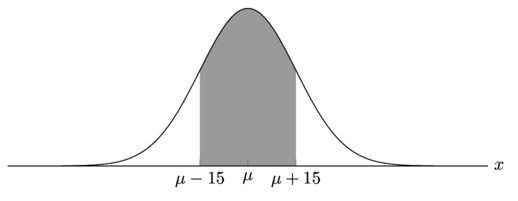
This means the time has to be within \mu - 15 and \mu + 15, since it has to differ from the mean by less than 15,
P(32.2 - 15 < X < 32.2 + 15)This simplifies to give,
P(17.2 < X < 47.2)Let’s standardize,
P\left(\frac{17.2 - 32.2}{9.6} < Z < \frac{47.2 - 32.2}{9.6}\right)This simplifies to give,
P(-1.563 < Z < 1.563)
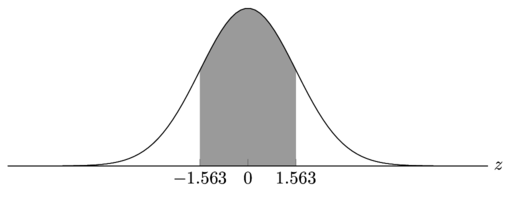
This is the same as,
P(-a < Z < a)This simplifies to,
2\phi(a) - 12\phi(1.563) - 1Read off the value of \phi(1.563) in the table,
\phi(\textcolor{red}{1.563}) = \textcolor{#2192ff}{0.9406} + \textcolor{#2192ff}{0.0004}\phi(\textcolor{red}{1.563}) = \textcolor{#2192ff}{0.941}

Substitute it into the expression,
2(\textcolor{#2192ff}{0.941}) - 10.882Therefore, the final answer is,
P(\mu - 15 < X < \mu + 15) = 0.8823. The time spent by shoppers in a large shopping centre has a normal distribution with mean 96 minutes and standard deviation 18 minutes. (9709/52/F/M/21 number 3)
(a) Find the probability that a shopper chosen at random spends between 85 and 100 minutes in the shopping centre.
Let’s start by defining our random variable,
X \textmd{- r.v, time, in minutes, spent by shoppers in a large}\\ \textmd{ shopping centre}State the distribution and parameters of the random variable,
X \sim N(96, 18^{2})Let’s write out our problem mathematically,
P(85 < X < 100)Let’s standardize,
P\left(\frac{85 - 96}{18} < Z < \frac{100 - 96}{18}\right)This simplifies to give,
P(-0.611 < Z < 0.222)
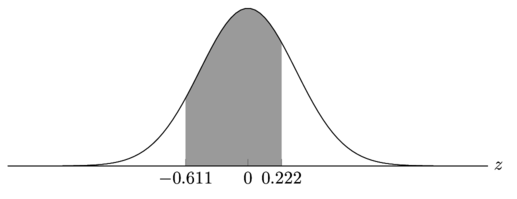
This is the same as,
P(-b < Z < a)This can be simplified as,
\phi(a) - (1 - \phi(b))\phi(0.222) - (1 - \phi(0.611))Read off the values of \phi(0.611) and \phi(0.222) from the table and substitute them into the expression,
\phi(\textcolor{red}{0.222}) - (1 - \phi(\textcolor{#0f0}{0.611}))\textcolor{red}{0.5871} + \textcolor{red}{0.0008} - (1 - \textcolor{#0f0}{0.7921} + \textcolor{#0f0}{0.0003})

\textcolor{red}{0.5879} - (1 - \textcolor{#0f0}{0.7294})0.3173Give your answer correct to 3 significant figures,
0.317Therefore, the final answer is,
P(85 < X < 100) = 0.317(b) 88\% of the shoppers spend more than t minutes in the shopping centre. Find the value of t.
In this case, you will notice that we’re given the area. This means we have to use the standard normal distribution in reverse. Let’s write out our problem mathematically,
P(X > t) = 0.88The formula for standardization is,
z = \frac{x - \mu}{\sigma}If we standardize we get,
P\left(Z > \frac{t - \mu}{\sigma}\right) = 0.88Let’s replace \frac{t - \mu}{\sigma} with z for better readability,
P(Z > z) = 0.88Let’s sketch the curve for our problem,
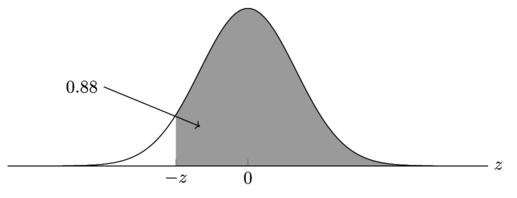
You will notice that our z-value is going to be negative. Let’s find our z-value. Start by converting 88\% to a decimal,
0.88Since 0.88 is greater than 0.500 we go straight into the main table. Find the value closest to but less than 0.88,
\textcolor{red}{0.8790}

Read off the values corresponding to 0.8790 from the first and second columns. These are 1.1 and 7 respectively, this gives,
1.17To get 0.88 we have to ADD \textcolor{red}{10} to the last two decimal places of \textcolor{red}{0.8790}. Now we read off the value that corresponds to ADD \textcolor{red}{10} in the row of 0.8790. ADD \textcolor{red}{10}, corresponds to \textcolor{#2192ff}{5}. Therefore, our z-value would be,
z = \textcolor{#2192ff}{1.175}

Remember that our z-value is supposed to be negative,
z = -1.175Now that we have found z we can now find t,
z = \frac{t - \mu}{\sigma}Substitute,
-1.175 = \frac{t - 96}{18}Make t the subject of the formula,
-1.175(18) = t - 96-21.15 = t - 96t = 96 - 21.15t = 74.85Give your answer correct to 3 significant figures,
t = 74.9Therefore, the final answer is,
t = 74.9
